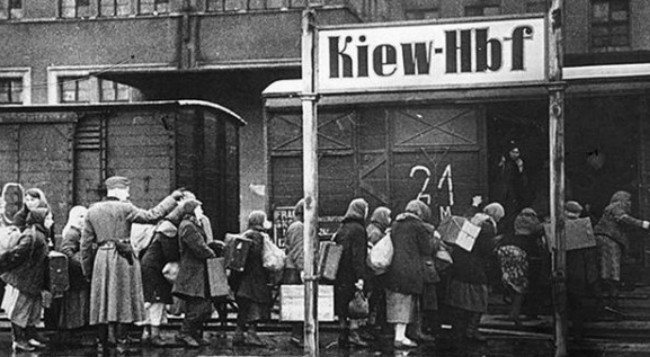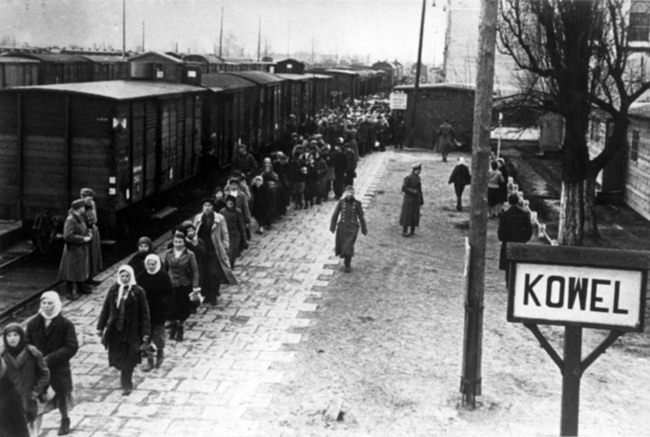Ostarbeiter
Ostarbeiter (eastern workers). The German term for several million civilians from the ‘conquered eastern territories’ taken to Germany for forced labor during the Second World War. The recruitment of workers was not part of the Germans' preinvasion planning, but it began, in November 1941, when it had become apparent that there would be no quick victory on the eastern front. The head of the Nazi Four-Year Plan, Hermann Göring, issued instructions in that month to the effect that ‘Russian’ workers should be used for Germany's benefit. In the same month the labor office of the Distrikt Galizien reported that 60,709 workers had been sent to Germany. At the beginning of 1942 a campaign was instituted under the auspices of the Four-Year Plan to supply 380,000 laborers for German agriculture and 247,000 for German industry. On 21 March F. Sauckel was appointed plenipotentiary general for labor allocation (Generalbevollmüachtiger für den Arbeitseinsatz, or GBA); he became Göring's subordinate in charge of recruiting ‘all available manpower, including foreigners and prisoners of war,’ to work in German industry and thereby allow the release of Germans for the war effort. Ukraine was by far the most important source of Ostarbeiter: of the approx 2.8 million civilians deported to Germany in 1941–4, about 2.2 million were from Ukraine.
Initially many Ukrainians greeted the Germans as liberators from Soviet rule, and 80 percent of the first labor quotas were filled by volunteers. But the brutal treatment of the volunteers, who were packed into freight cars without food or sanitary facilities, soon became known in Ukraine. By the summer of 1942 there were no more volunteers. With their increasing appetite for manpower, the Germans resorted to forcible means of recruitment. People were rounded up arbitrarily to make up the quotas imposed by the GBA. Towns and villages were ordered to register the able-bodied and to supply quotas of workers; those who failed to report for duty were subject to confiscation of grain and property, the burning down of their houses and villages, and incarceration in concentration camps. Official reports and German soldiers' letters to relatives described the beatings and mistreatment of Ostarbeiter as everyday occurrences in Ukraine. Families were often separated, and relatives who tried to give departing workers food and clothing were brutally thrust aside. All that helped to turn popular sentiment decisively against the Germans and encouraged those who faced deportation to join the Soviet partisans (see Soviet partisans in Ukraine, 1941–5) or the Ukrainian Insurgent Army. The return of disabled Ostarbeiter to Ukraine—the seriously ill, injured, or undernourished, who could not usefully contribute to the war effort—intensified anti-German feelings. Throughout 1942 and 1943 the forced requisition of workers in Ukraine took a dreadful toll in manpower. In Kyiv, for example, instructions were given in April 1942 to round up 20,000 workers aged 16 to 55. In September 1942 part of the city was cordoned off, and all unemployed able-bodied inhabitants were pressed into service. By the summer of 1943, 440,000 workers had been deported from the greater Kyiv area, with the result that German security police protested there were not enough workers left to gather the harvest.
Irrational aspects of Nazi policy lessened the effectiveness of Ostarbeiter recruitment. Tens of thousands of workers were brought to Germany only to be sent back when they were found unsuitable for employment. A report from Kharkiv dated October 1942 pointed out that specialist workers were being forced to leave Ukraine without proper clothing and were being beaten so severely that they were unfit for work. Adolph Hitler's scheme of recruiting half a million Ukrainian women ‘capable of being Germanized’ as domestic workers failed to yield the expected results: Sauckel was able to bring in only 15,000. In Germany Ostarbeiter were treated worse than forced laborers from other German-occupied countries. Ukrainians from the Reichskommissariat Ukraine were not recognized as Ukrainian nationals, a status accorded only to those from the Distrikt Galizien. Every effort was made to isolate the Ostarbeiter from the German population and from workers of other nationalities by placing them in closed residences. So great was the fear of ‘pollution’ by the easterners, whom Nazi propaganda described as subhuman, that the death penalty was instituted for sexual intercourse with them, and for numerous other offenses. Every article of clothing Ostarbeiter wore had to be identified with an ‘Ost’ badge. Whereas the average German industrial worker earned 3.50 reichsmarks (RM) per day, an Ostarbeiter earned 2.30, 1.50 of which was deducted for room and board; Ostarbeiter working in agriculture averaged a net wage of 3 rm per week. Ostarbeiter received smaller food rations than other foreign workers. German maternity laws did not apply to female Ostarbeiter, and their children received half the rations allocated to German children. Most Ostarbeiter worked in private enterprises but were kept under close surveillance by the German police and the SS. Those caught trying to escape were sent to concentration camps or killed. In the autumn of 1942, officials of the Ostministerium began to complain that the brutal treatment of Ostarbeiter was turning the population against the Germans, and military officers warned that it was leading to an increase in the number of anti-German partisans. The criticism resulted in a slight improvement in the status of the Ostarbeiter: their take-home wages were raised to 1.14 rm, a 20 percent rebate of taxes on wages was accorded for excellent work, and a central inspection agency was created to supervise working conditions.
Despite official rhetoric urging better treatment of Ostarbeiter and a growing tendency to equalize their status with that of other foreign workers, measures designed to assist them depended on the goodwill of German employers and were hampered by wartime conditions. The productivity of Ostarbeiter labor was strikingly high. According to a comprehensive survey conducted in 1944, the productivity of male workers was 60–80 percent of that of their German counterparts, and that of female workers attained a level of 90–100 percent. After the war most Ukrainian Ostarbeiter in occupied Germany were forcibly repatriated to the Union of Soviet Socialist Republics, where many were victimized for having ‘betrayed the Fatherland’ by allowing themselves to be captured. (See also Nazi war crimes in Ukraine and Repatriation.)
BIBLIOGRAPHY
Dallin, A. German Rule in Russia, 1941–1945: A Study of Occupation Policies (London and New York 1957; London 1981)
Homze, E. Foreign Labor in Nazi Germany (Princeton 1967)
Herbert, U. A History of Foreign Labor in Germany, 1880–1980: Seasonal Workers/Forced Laborers/Guest Workers (Ann Arbor 1990)
Myroslav Yurkevich
[This article originally appeared in the Encyclopedia of Ukraine, vol. 3 (1993).]

